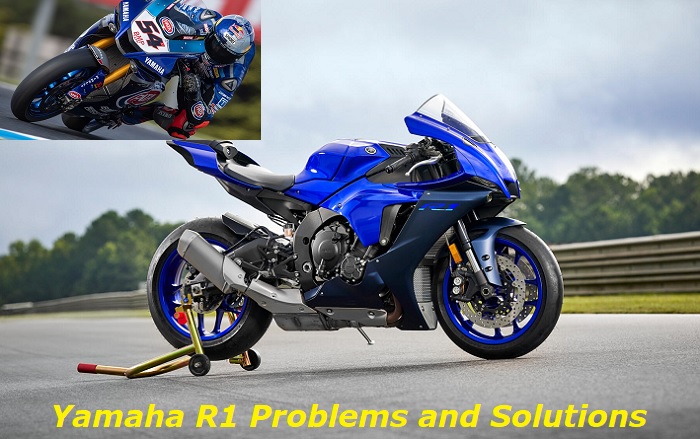If you are a Yamaha R1 motorcycle owner, then you know this bike is one of the best on the market. First introduced in 1998, the R1 quickly became a favorite among riders and critics alike for its incredible performance and handling.
Now in its 8th generation, the R1 continues to impress with its cutting-edge technology and race-bred engineering. It's no wonder that the R1 is one of the most popular sports bikes on the market today.

However, as with any other vehicle, there can be some issues that may arise. In this article, we will discuss some of the most common Yamaha R1 problems and ways to avoid them.
What are some of the common Yamaha R1 problems that you should be aware of before purchasing one
The most common Yamaha R1 problems include:
- High oil consumption
This is caused by the fact that the engine of the Yamaha R1 burns oil at a higher rate than other motorcycles. As such, you will need to check the oil level more often and top it up when necessary.
- Transmission problems
The R1 has been plagued by transmission problems since its inception. The most common issue is the infamous "false neutral" problem, where the bike will seemingly go into neutral on its own while riding. This can be extremely dangerous, as it can cause the rider to lose control of the bike and crash. Other transmission issues include gear skipping, hard shifting, and general poor shifting quality.
A faulty input shaft bearing causes the Yamaha YZF-R1 transmission problems. This bearing is located in the gearbox, and over time, it can become damaged or worn out. As a result, it can cause the gears to grind or slip, which will eventually lead to the transmission failing.
Yamaha has issued several recalls on the R1's transmission, but the problems persist. Many owners have simply given up on the bike and sold it, while others have tried to rebuild the transmission themselves. Yamaha has tried to address these issues and made some improvements to the transmission for the 2018 model year. However, this didn't solve all the issues.
- Yamaha R1's 2015 Crankshaft Failures
While crankshaft failures are relatively common in different Yamaha R1 models, there have been many reports of crankshaft failures on Yamaha R1s 2015 model. It is advisable to check the crankshaft regularly for any signs of wear and tear and replace it when necessary.
- Battery problems
Some owners have reported having issues with the battery of their R1, leading to starting issues. It can be recommended to replace the Yahama OEM battery with a Shorai Lithium-Iron battery which is known to be more durable.
- Oil leaks
One of the most common Yamaha R1 problems is oil leaks. These can occur for a variety of reasons, such as a loose oil drain plug or an issue with the engine gaskets. If you notice any oil leaks, it's important to have them checked out by a professional to prevent any significant potential damage.
- Leaking forks
This is a common issue with the Yamaha R1 that can be caused by wear and tear. It is advisable to check the forks regularly for any leaks.
- Brake problems
Another common issue with the Yamaha R1 is brake problems. This is usually caused by the pads wearing out prematurely. As such, you will need to replace the pads more often than with other motorcycles.
- Coolant leaks
This is another common issue with the Yamaha R1 that can be caused by a number of factors, such as a loose radiator cap or a faulty water pump.
- Rotor Problems on Older Models
Some owners of older model Yamaha R1s have reported having issues with the rotors. It is advisable to check the rotors regularly for any wear and tear and replace them when necessary.
- Clutch rattle
This is a common issue with the Yamaha R1 that can be caused by the clutch being worn out. This issue is also related to older models.
- Headlights turn off/on their own
The owners of older models also complain about this issue. It is caused by a loose connection in the headlight circuit.
- Any other issues?
In addition to the aforementioned problems, many Yamaha R1 owners mention that it is quite uncomfortable to ride. The seat can be hard and narrow, and the footpegs are placed high up, making it difficult to find a comfortable riding position. The bike can also be vibey, making long rides tiring.
So, if you're looking for a comfortable ride, the Yamaha R1 might not be the best choice. However, it could be just what you're after if you're looking for speed and power.
How can you avoid these issues and keep your motorcycle running smoothly for years to come
The best way to avoid Yamaha R1 problems is to buy a newer model that has been updated with the latest improvements. However, you can also avoid problems on older models by using the following recommendations:
- Check the oil level of your Yamaha R1 regularly and top up when necessary.
- Replace the OEM battery.
- Inspect the engine gaskets regularly for any leaks.
- Replace the fork seals every few years to prevent leaking.
- Change the brake pads more frequently than with other motorcycles.
- Check the chain regularly and replace it when necessary.
- Inspect the radiator cap and water pump for any leaks.
By following these tips, you can help avoid many of the most common Yamaha R1 problems and keep your motorcycle running smoothly for years to come.
What to do if you encounter a problem while riding your Yamaha R1
If you encounter a problem while riding your Yamaha R1, the best thing to do is to stop and turn off your engine. Once the engine is off, you can assess the situation and decide whether you need to call a tow truck or if you can fix the problem yourself. If you are not sure what to do, it is always best to call a tow truck or take the bike to a professional mechanic. Attempting to fix the problem yourself may result in further damage to your motorcycle.
Where can you go for help if something does go wrong with your Yamaha R1
Suppose you experience some problems with your Yamaha R1. In that case, it is always best to take it to a qualified mechanic or Yamaha dealership for help. Trying to fix the issue yourself could end up costing you more in the long run if you do not know what you are doing.
There are also a number of online forums where you can go for help and advice from other Yamaha R1 owners. This is a great resource to use if you are experiencing any issues with your motorcycle.
Where can you find replacement parts and accessories if something goes wrong with your bike?
If you need to replace any parts or accessories on your Yamaha R1, the best place to look is online. There are a number of websites that sell aftermarket and OEM parts for Yamaha motorcycles.
Another great resource for finding replacement parts and accessories is your local Yamaha dealership. They should be able to order the part you need and have it shipped to you.
How much should you expect to pay for repairs and maintenance on a bike like this
The cost of repairs and maintenance on a Yamaha R1 will vary depending on the problem. However, you can expect to pay around $200-$500 for minor repairs and $2000-$6000 for major repairs.
The cost of parts and labor will be greater if you take your motorcycle to a dealership or specialist mechanic rather than a general mechanic.
Regarding maintenance, you should budget around $400-$800 per year, depending on how old your bike is and how much you drive. This will cover the cost of things like oil changes, new brake pads, and general servicing.
Is it worth trying to fix it yourself?
There are a few things that you can do to try and fix Yamaha R1 problems yourself, such as checking the oil level and changing the brake pads. However, if you experience any major issues, such as an engine failure, it is best to take it to a mechanic.
Attempting to fix a complex issue yourself is always risky. So, if you don't have enough knowledge and experience, you should ask for professional help.
Conclusion
The Yamaha R1 is a great motorcycle, but it does have its fair share of problems. However, if you are aware of the most common issues and take steps to avoid them, you can prevent your Yamaha R1 from being damaged.
Just remember to take it to a qualified mechanic if you do experience any problems.
About the authors
The CarAraC research team is composed of seasoned auto mechanics and automotive industry professionals, including individuals with advanced degrees and certifications in their field. Our team members boast prestigious credentials, reflecting their extensive knowledge and skills. These qualifications include: IMI: Institute of the Motor Industry, ASE-Certified Master Automobile Technicians; Coventry University, Graduate of MA in Automotive Journalism; Politecnico di Torino, Italy, MS Automotive Engineering; Ss. Cyril and Methodius University in Skopje, Mechanical University in Skopje; TOC Automotive College; DHA Suffa University, Department of Mechanical Engineering






Add comment